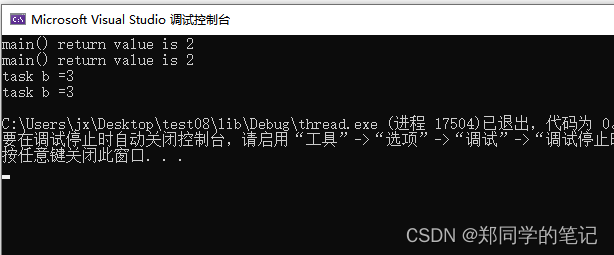【并发编程十一】c++线程同步——future
| 阿里云国内75折 回扣 微信号:monov8 |
| 阿里云国际,腾讯云国际,低至75折。AWS 93折 免费开户实名账号 代冲值 优惠多多 微信号:monov8 飞机:@monov6 |
【并发编程十一】c++线程同步——future
简介
本篇文章我们详细的介绍下c++标准库提供的线程同步方法——future。
一、互斥
二、条件变量
参见【并发编程十】c++线程同步——条件变量condition_variable
三、future
类模板 std::future 提供访问异步操作结果的机制
- 通过std::async 、 std::packaged_task 或 std::promise 创建的异步操作能提供一个 std::future 对象给该异步操作的创建者。
- 然后异步操作的创建者能用各种方法查询、等待或从 std::future 提取值。若异步操作仍未提供值则这些方法可能阻塞。
- 异步操作准备好发送结果给创建者时它能通过修改链接到创建者的 std::future 的共享状态例如 std::promise::set_value 进行。
注意 std::future 所引用的共享状态不与另一异步返回对象共享与 std::shared_future 相反。

1、promise
- 类模板 std::promise 提供存储值或异常的设施之后通过 std::promise 对象所创建的 std::future 对象异步获得结果。注意 std::promise 只应当使用一次。
备注简单来说就是以下过程
- 1、把promis和future绑定。
- 2、promise设置值后
- 3、future等待直到获取值。
1.1、子线程设值主线程获取
- demo
#include <iostream>
#include <future>
#include <thread>
using namespace std;
void task(int a, int b, promise<int>& p)
{
p.set_value(a + b);
}
int main()
{
// 把promise和future做关联
promise<int> p;
future<int> f=p.get_future();
thread task1(task,1,2,ref(p));
//do somesthing
//get promise value
f.wait();
cout << "return value is " << f.get() << '\n';//只能get一次。
task1.join();
}
- 输出
1.2、主线程设置值子线程获取
- demo
#include <iostream>
#include <future>
#include <thread>
using namespace std;
void task(int a, future<int>& b, promise<int>& p)
{
p.set_value(a + b.get());
}
int main()
{
// 把promise和future做关联
promise<int> p_ret;
future<int> f_ret=p_ret.get_future();
promise<int> p_in;
future<int> f_in = p_in.get_future();
thread task1(task,1,ref(f_in),ref(p_ret));
//do somesthing
//...
p_in.set_value(3);
//get promise value
f_ret.wait();
cout << "return value is " << f_ret.get() << '\n';//只能get一次。
task1.join();
}
- 输出
1.3、shared_future
2、async
异步运行一个函数有可能在新线程中执行并返回保有其结果的 std::future.
2.1、不开新线程的async
- demo
#include <iostream>
#include <future>
#include <thread>
using namespace std;
int task(int a, int b)
{
return a + b;
}
int main()
{
// 把async和future做关联
future<int> f = async(task, 1, 5);
//get future value
f.wait();
cout << "return value is " << f.get()<< '\n';
}
- 输出
2.2、开新线程的async
- launch::async意思是创建新的线程。
- launch::deferred和不传默认参数是一样的相当于延时调用。
#include <iostream>
#include <future>
#include <thread>
using namespace std;
int task(int a, int b)
{
return a + b;
}
int main()
{
// 把async和future做关联
future<int> f = async(launch::async,task, 1, 5);
//get future value
f.wait();
cout << "return value is " << f.get()<< '\n';
}
输出结果和不开线程一样的
3、packaged_task
- 打包一个函数存储其返回值以进行异步获取
3.1、不使用bind
- demo
#include <iostream>
#include <future>
#include <thread>
using namespace std;
int task(int a, int b)
{
return a + b;
}
int main()
{
// 调用packaged_task的构造函数返回值和两个参数都是int类型
packaged_task<int(int, int)> t(task);
//执行
t(5,5);
// 把packaged_task和future做关联
future<int> f = t.get_future();
//获取返回值的结果
f.wait();
cout << "return value is " << f.get()<< '\n';
}
输出
3.2、提前指定参数
#include <iostream>
#include <future>
#include <thread>
using namespace std;
int task(int a, int b)
{
return a + b;
}
int main()
{
// 调用packaged_task的构造函数返回值和两个参数都是int类型
packaged_task<int()> t(std::bind(task,11,12));
//执行
t();
// 把packaged_task和future做关联
future<int> result = t.get_future();
//获取返回值的结果
result.wait();
cout << "return value is " << result.get()<< '\n';
}
- 输出
3.3、bind
bind返回参数为std::function
- demo
#include <iostream>
#include <future>
#include <thread>
using namespace std;
int task(int a, int b)
{
return a + b;
}
int main()
{
// bind返回值为std::function
auto a = bind(task, 11, 14);
//执行
int result = a();
cout << "return value is " << result << '\n';
}
- 输出
备注既然bind就可以获取结果为何还要用packaged_task当然是因为future啊。
4、shared_future
- future只能get一次那如果我们想用使用多次的get呢———答使用shared_future。
- 网上的例子基本都是shared_future和async放在一起使用。
- 网上并没有shared_future和promise一起使用的例子所以我们写下后者的例子demo.
#include <iostream>
#include <future>
#include <thread>
using namespace std;
mutex mtx;
void task(int a, shared_future<int>& b, promise<int>& p)
{
p.set_value(2);
b.wait();
int bb = b.get();
lock_guard<mutex> guard(mtx);
cout << "task b =" << b.get()<<endl;
}
int main()
{
// 把promise和future做关联
promise<int> p_ret_1,p_ret_2;
future<int> f1 = p_ret_1.get_future();
future<int> f2 = p_ret_2.get_future();
promise<int> p_in;
shared_future<int> s_f = p_in.get_future();
thread task1(task, 1, ref(s_f), ref(p_ret_1));
thread task2(task, 2, ref(s_f), ref(p_ret_2));
//do somesthing
f1.wait();
f2.wait();
//...
p_in.set_value(3);
//get promise value
{
lock_guard<mutex> guard(mtx);
cout << "main() return value is " << f1.get() << '\n';//只能get一次。
cout << "main() return value is " << f2.get() << '\n';//只能get一次。
}
task1.join();
task2.join();
}
- 输出
参考
1、https://www.apiref.com/cpp-zh/cpp/thread.html
2、https://en.cppreference.com/w/cpp/thread
3、书籍《c++服务器开发精髓》——张远龙








